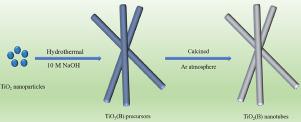Journal of the Taiwan Institute of Chemical Engineers ( IF 5.5 ) Pub Date : 2021-12-10 , DOI: 10.1016/j.jtice.2021.104164 Dan Liu 1 , Huzhen Li 2 , Kaifeng Li 2 , Mengmeng Zhen 2, 3

|
Background
The shuttling of lithium polysulfides (LiPSs) between anode and cathode in lithium-sulfur batteries (LSBs) has been seriously restricted their actual electrochemical performances. Coating modifications on the surface of separators is considered an effective strategy to improve the battery performances. Metal oxides, especially TiO2 as separator modifications can restrain the shuttle effect of LiPSs to a certain extent. It could be the inappropriate microstructure or limited crystal structure of TiO2, resulting in the non-ideal cycling performances of LSBs. Compared with other TiO2 phase, nanotube structured TiO2-Bronze (TiO2(B)) owns characteristic required for ideal separator modifications. However, there are relatively few studies about ultrathin-walled TiO2(B) nanotubes as separator modifications.
Methods
In this paper, ultrathin-walled TiO2(B) nanotubes (TiO2(B)-NTs) were constructed through a facile hydrothermal synthesis combined with high-temperature calcination method.
Significant findings
The DFT calculations and electrochemical tests of LSBs proved that the ultrathin-walled TiO2(B)-NTs as separator modifications have several advantages: strong chemical entrapment for LiPSs; fast lithium-ion diffusivity and strong catalytic activity. Consequently, compared with nanorod structured TiO2(B) and CNTs, the TiO2(B)-NTs as separator modifications deliver superior cycling performances with ∼805 mAh g−1 at 1.0 C after 80 cycles and ∼235 mAh g−1 at 5.0 C after 600 cycles, and good rate capabilities in LSBs.
中文翻译:

用于锂硫电池的超薄壁 TiO2(B) 纳米管的吸附、扩散和电催化三重效应
背景
在锂硫电池(LSBs)中,多硫化锂(LiPSs)在阳极和阴极之间的穿梭严重限制了它们的实际电化学性能。隔膜表面的涂层改性被认为是提高电池性能的有效策略。金属氧化物,特别是TiO 2作为隔膜改性剂可以在一定程度上抑制LiPSs的穿梭效应。这可能是TiO 2不合适的微观结构或有限的晶体结构,导致LSBs的循环性能不理想。与其他 TiO 2相相比,纳米管结构的 TiO 2 -Bronze (TiO 2(B)) 具有理想分离器修改所需的特性。然而,关于超薄壁 TiO 2 (B) 纳米管作为隔膜改性的研究相对较少。
方法
本文通过简便的水热合成结合高温煅烧法构建了超薄壁TiO 2 (B)纳米管(TiO 2 (B)-NTs)。
重要发现
LSBs 的 DFT 计算和电化学测试证明,作为隔膜改性的超薄壁 TiO 2 (B)-NTs 具有几个优点:对 LiPSs 具有很强的化学捕获能力;锂离子扩散快,催化活性强。因此,与纳米棒结构的 TiO 2 (B) 和 CNT 相比,作为隔膜改性的 TiO 2 (B)-NT 提供了优异的循环性能,在 80 次循环后在 1.0 C 时约为 805 mAh g -1 ,在循环后约为 235 mAh g -1 600 次循环后为 5.0 C,并且在 LSB 中具有良好的速率能力。











































 京公网安备 11010802027423号
京公网安备 11010802027423号